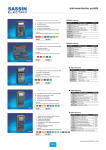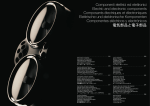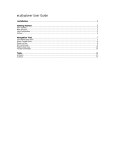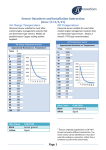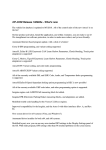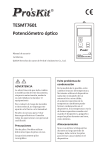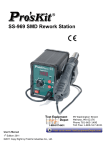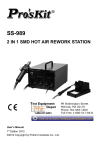Download Pro'sKit MT-7600 User`s manual
Transcript
MT-7600 Fiber Optic Power Meter 99 Washington Street Melrose, MA 02176 Phone 781-665-1400 Toll Free 1-800-517-8431 User’s Manual Visit us at www.TestEquipmentDepot.com 1st Edition, 2011 ©2011 Copy Right by Prokit’s Industries Co., Ltd. Overview Thank you for purchasing this instrument. To get the best use of your equipment and ensure safe operation to provide the best possible reliability, convenience and performance, please spend a few minutes to read this manual. For the absolute power measurement and relative measurement of the link loss in dB, thanks to its friendly operation interface, broad power measurement range, high precision and high performance in application makes it an ideal tool for optical fiber network. Application The MT-7600 Fiber Optic Power Meter is used for field or laboratory testing of fiber optic systems at typically 850, 1300, 1310 and 1550 nm. It features superb measurement confidence, ease of use and reduced cost of ownership, and is for use by installers, technicians and engineers, telecom construction, maintenance, CATV, LAN and R&D applications. Specifications 1. 2. 3. 4. 5. 6. 7. 8. 9. 10. 11. 12. 13. Sensor Element: InGaAs Calibration Wavelengths: 850nm , 1300nm , 1310nm , 1550nm. Power Range: +3dBm ~ -55dBm , 2mW ~ 4nW. Resolution: 0.01. Accuracy: 0.3dBm. Connector: Multi-connector (ST, FC, SC 3 in 1) Overload indication. Low battery indication. Auto-power-off function. Back-light function.. Operating / storage: -0 to 50°C / -20 to 60°C (0~80%RH) Power: 4 alkaline battery 1.5V (not included) Accessories: User manual Carrying case 1 piece of SC Patch cord LC adaptor (optional) 14. Size: 185 x 84 x 42 mm 15. Weight: 420 g 1 Names of Parts 6 1. Multi-connector (ST, FC, SC three in one) 2. LCD. 3. Power ON/OFF button. 4. Function button keypad. 5. Back-light push button. 6. Battery cover Operation 1. Press the On/Off key to turn on the Power Meter 2. Press the λ key to set wavelengths that you want to measure. 3. Connect the optical net to be measured, and then reading will be displayed on the LCD screen, including Linear and nonlinear value. 4. Relative power measurement. Press dB key, then current power value is stored as a reference value in dB unit. Optic Network System 2 Appendix: Optical fiber loss measurement Step 1- Optical Reference Level Turn on optical power meter and press the λ key to select the wavelength. Turn on optical light source and select the wavelength. Wait for 1-2 minutes until it stabilize. Select a piece of patch cords, which is used to connect with the light source. The patch cords must be the same fiber type as the fiber under test. Connect the light source with the Power Meter through the source patch cords. Power Meter will get the power measurement value. This value should be close to the value of the light source. If it has wide disparity, please make sure the fiber connection is clean properly else replace jumpers. Press the dB key; 0dB will be displayed on the screen. The tested power values will be set to the reference value. Step 2-Optical Loss Measurement Keep the source patch cords connection with the light source. Connect the Power Meter and light source (emitting source) to the optical fiber link respectively. LCD Display 850nm 1300nm HI AUTO OFF 1310nm 1550nm dBm mWuW dB nWpW 1. Low-Battery indicator: Please use alkaline battery to increase normal operation time. When low-bat indicator is lighted, please change battery immediately. This can assure the stability of power. 2. Wave length: Display currently measurable wavelength. 3 3. dBm: Display currently selected unit as dBm. 4. Watt mode: When watt is selected, mW, uW, nW, pW, will be displayed subject to the size of signal. 5. dB mode: When dB is displayed , difference between two signals can be measured. 6. Measurement display: Display the value of signal measured. 7. Auto-power-off: To stop the instrument turning off 40 minutes after the last key press. Button Key Pad 1. Power button: Push the yellow POWER button. The display will come on. Pushing POWER button again will turn the instrument off. 2. dBm/W: Push “dBm/W” to change the dBm display between linear and log. 3. λ: Push “ λ” to Switch the operating wavelength between 850nm,1300nm,1310nm, 1550nm. 4. dB: push “dB” to display relative power, display will show dB R. Back-light button: Push the button to turn the back-light ON or OFF. 5. The back will automatic off after lighted 50 seconds. 4 CARE OF YOUR INSTRUMENT 1. Always clean the mating connector tip and ferrule before mating, using approved materials. Clean the instrument using alcohol or other non solvent cleaning agents. Acetone or other active solvents may damage the case. 2. When not in use, keep connectors covered and away from dust. Dust and other particles, however, can range from tenths to hundredths of microns in diameter. Their comparative size means that they can cover a part of the end of a fiber core, and as a result will reduce the performance of your system 3. During prolonged storage, remove batteries to eliminate the possibility of acid leakage. Use only high quality sealed alkaline batteries. 4. Do not touch connector tips with your fingers, since body oils and dirt can impair connector performance. 5. Do not use damaged or incompatible connectors. 6. Limit the input optical power doesn’t over measuring range. 7. The instrument is resistant to normal dust and moisture, however it is not waterproof. If moisture does get into the instrument, dry it out carefully before using it again. 8. This meter is a high-accuracy correct instrument, don't disassembly or open it by yourself, otherwise the quality is not guaranteed. 9. During storage and transport, keep the instrument in its carry case to protect against crushing, vibration, dust and moisture. 10. Where possible, keep instrument away from strong sunlight. Procedure for Stubborn Dirt 1. Moisten a new cotton swab with alcohol. 2. Clean the interface by rubbing the cotton swab over the surface using a small circular movement. 3. Take a new, dry soft tissue and remove the alcohol, dissolved sediment and dust, by rubbing gently over the surface using a small circular movement. 4. Blow away any remaining lint with compressed air. 5







